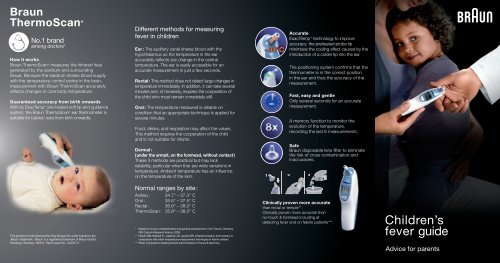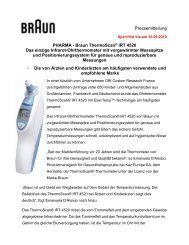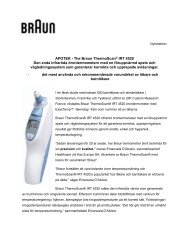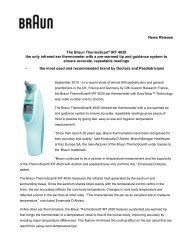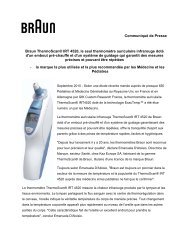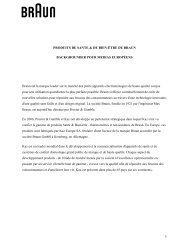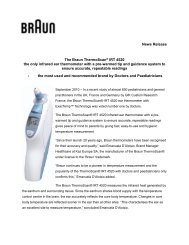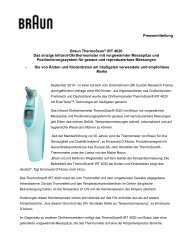Braun ThermoScan - Kaz Europe SA
Braun ThermoScan - Kaz Europe SA
Braun ThermoScan - Kaz Europe SA
You also want an ePaper? Increase the reach of your titles
YUMPU automatically turns print PDFs into web optimized ePapers that Google loves.
<strong>Braun</strong><br />
<strong>ThermoScan</strong> ®<br />
No.1 brand<br />
among doctors*<br />
How it works<br />
<strong>Braun</strong> <strong>ThermoScan</strong> ® measures the infrared heat<br />
generated by the eardrum and surrounding<br />
tissue. Because the eardrum shares blood supply<br />
with the temperature control centre in the brain,<br />
measurement with <strong>Braun</strong> <strong>ThermoScan</strong> accurately<br />
refl ects changes in core body temperature.<br />
Guaranteed accuracy from birth onwards<br />
With its ExacTemp pre-heated soft tip and guidance<br />
system, the <strong>Braun</strong> <strong>ThermoScan</strong> ® ear thermometer is<br />
suitable for babies’ ears from birth onwards.<br />
This product is manufactured by <strong>Kaz</strong> <strong>Europe</strong> <strong>SA</strong> under license to the<br />
‘<strong>Braun</strong>’ trademark. ‘<strong>Braun</strong>’ is a registered trademark of <strong>Braun</strong> GmbH,<br />
Kronberg, Germany. ©2011, <strong>Kaz</strong> <strong>Europe</strong> <strong>SA</strong> - 24OCT11<br />
Different methods for measuring<br />
fever in children<br />
Ear : The auditory canal shares blood with the<br />
hypothalamus so the temperature in the ear<br />
accurately refl ects any change in the central<br />
temperature. The ear is easily accessible for an<br />
accurate measurement in just a few seconds.<br />
Rectal : This method does not detect large changes in<br />
temperature immediately. In addition, it can take several<br />
minutes and, of necessity, requires the cooperation of<br />
the child who must remain completely still.<br />
Oral : The temperature measured is reliable on<br />
condition that an appropriate technique is applied for<br />
several minutes.<br />
Food, drinks, and respiration may affect the values.<br />
This method requires the cooperation of the child<br />
and is not suitable for infants.<br />
Dermal :<br />
( under the armpit, on the forehead, without contact )<br />
These 3 methods are practical but may lack<br />
reliability, particular when ther are wide variations in<br />
temperature. Ambient temperature has an infl uence<br />
on the temperature of the skin.<br />
Normal ranges by site :<br />
Axillary : 34.7° – 37.3° C<br />
Oral : 35.5° – 37.5° C<br />
Rectal : 36.6° – 38.0° C<br />
<strong>ThermoScan</strong> : 35.8° – 38.0° C<br />
* Based on survey of pediatricians and general practitioners in UK, France, Germany.<br />
GfK Custom Research France, 2009<br />
** Nimah MM, Behesh K., Callahan JD, Jacobs BR, Infrared tympanic thermometry in<br />
comparison with other temperature measurement techniques in febrile children.<br />
*** When compared to leading temple thermometers in France & Germany.<br />
1 2 3<br />
Accurate<br />
ExactTemp technology to improve<br />
accuracy: the preheated probe tip<br />
minimises the cooling effect caused by the<br />
introduction of a colder tip into the ear.<br />
The positioning system confi rms that the<br />
thermometer is in the correct position<br />
in the ear and thus the accuracy of the<br />
measurement.<br />
Fast, easy and gentle<br />
Only several seconds for an accurate<br />
measurement.<br />
A memory function to monitor the<br />
evolution of the temperature,<br />
recording the last 8 measurements.<br />
Safe<br />
<strong>Braun</strong> disposable lens fi lter to eliminate<br />
the risk of cross-contamination and<br />
inaccuracies.<br />
Clinically proven more accurate<br />
than rectal or temple**.<br />
Clinically proven more accurate than<br />
no-touch & forehead including at<br />
detecting fever and on febrile patients***.<br />
Children’s<br />
fever guide<br />
Advice for parents<br />
<strong>Braun</strong>_<strong>ThermoScan</strong>_FeverLeaflet_EN_24OCT11.indd 1 11/15/11 5:29 PM
<strong>Braun</strong><br />
<strong>ThermoScan</strong> ®<br />
most used and recommended<br />
by doctors and paediatricians*<br />
Fever in children<br />
Body temperature, also known as the central temperature,<br />
is regulated by hypothalamus (the temperature control<br />
center in the brain).<br />
Fever is defi ned as a central temperature higher than 38° C.<br />
It is one of the body’s natural defense mechanisms for<br />
fi ghting bacterial and viral infections.<br />
It is not a disease, but a symptom often associated with<br />
others : pain, diarrhea, vomiting, headache, fatigue, etc.<br />
In general, the fever precedes appearance of an illness<br />
by several hours. In the majority of cases this illness will<br />
not be serious.<br />
How often should<br />
the temperature be taken ?<br />
Monitor the temperature very regularly, including during<br />
the night. If there is a high fever, increase the frequency<br />
up to once an hour. Note the different measurements<br />
and the time in order to provide the doctor with this<br />
useful information.<br />
Simple gestures to improve<br />
your child’s condition :<br />
• Dress him/her in light clothing, such as light cotton<br />
and cover him/her with just a sheet.<br />
• Make sure the temperature in his/her room does not<br />
exceed 19° C/20° C. Avoid draughts.<br />
• If your child is not suffering form diarrhea, give him<br />
liquids to prevent dehydration : water, fruit juice diluted<br />
in water, vegetable soup, or small quantities<br />
of milk frequently.<br />
Illnesses with fever<br />
Situations<br />
Teething<br />
Reactions to<br />
vaccinations<br />
Rhinopharyngitis<br />
Bronchiolitis<br />
This list is not exhaustive, ask your doctor for advice.<br />
Temperature<br />
scales<br />
High fever > from 38.5° C<br />
Moderate fever 37.8° to 38.5° C<br />
No fever < 37.8° C<br />
Symptoms<br />
Grumpy child who dribbles<br />
Red gum<br />
Fever<br />
Pain and redness at the injection site<br />
Fever<br />
Runny or blocked nose<br />
Fever<br />
Cough<br />
Dry cough<br />
Breathing problems which may be<br />
accompanied by wheezing<br />
Restless child who refuses meals<br />
Fever<br />
What to do in addition to the normal measures for treating the fever<br />
• Rub your child’s gums gently with a fi nger or some crushed ice.<br />
• Give your child a plastic teething ring that has been kept<br />
in the refrigerator to bite on.<br />
• Apply teething gels or lotions that are available from pharmacies<br />
to reduce the pain.<br />
• If there is persistent pain or fever, give your child paracetamol after<br />
medical advice.<br />
• Apply an ointment available from pharmacies to the painful area and<br />
give your child medicine for the fever.<br />
• If the problems persist for more than 48 hours, call your doctor.<br />
• Wipe your child’s nose regularly.<br />
• Make the nasal discharge more fl uid by using saline solution.<br />
• Raise your child’s head when he sleeps by placing a pillow under<br />
his mattress.<br />
• Reduce your child’s temperature and improve his cough.<br />
• The choice of cough medicine depends on the type of cough.<br />
Ask advice from your pharmacist.<br />
• Give your child frequent, small meals.<br />
• Raise your child’s chest using cushions placed under the mattress.<br />
• Relieve your child’s fever with paracetamol after medical advice.<br />
• Bronchiolitis is an illness which can have serious consequences.<br />
If your child’s condition shows signs of worsening, contact your doctor<br />
immediately.<br />
• Place a humidifi er in the child’s bedroom to help open up the blocked<br />
airways and to relieve the effects of the cough and cold.<br />
Source: Information on the treatment of fever in children: afssaps<br />
(French Agency for the Safety of Health Products), January 2005.<br />
Childhood illnesses: Guide to symptoms ; Marabout Pratique<br />
Call your doctor or accident and emergency<br />
in certain cases:<br />
• If your child’s fever does not disappear after 24 hours.<br />
• If your child’s condition shows signs of worsening either overall or<br />
separately : change in normal behaviour, greyish complexion, diffi culty<br />
in reacting or breathing, small purplish spots on the skin, tremors.<br />
<strong>Braun</strong>_<strong>ThermoScan</strong>_FeverLeaflet_EN_24OCT11.indd 2 11/15/11 5:29 PM


